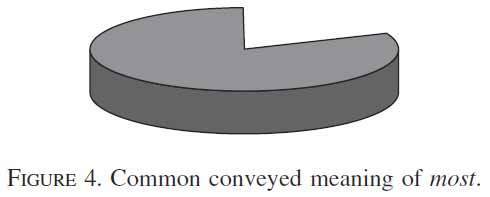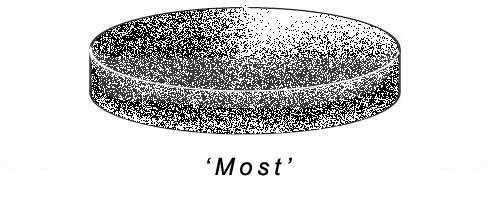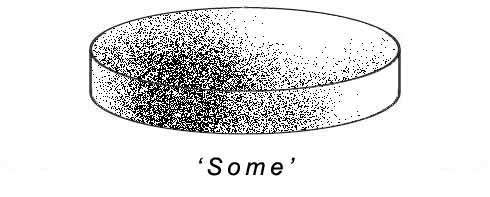‘Most’ — what does it mean, mostly?
 On a day-to-day basis, a good many, perhaps even the majority, of those outside academia tend to work with a broad definition of the meaning of the word ‘Most’.
On a day-to-day basis, a good many, perhaps even the majority, of those outside academia tend to work with a broad definition of the meaning of the word ‘Most’.
Something along the lines of ‘More than half’, but stopping a little short of ‘All’. [see figure 4, from study below].
But some, who study linguistics, are keen to pin down ‘most’ a little more tightly. Take for example Mira Ariel , Ph.D. who is Professor of pragmatics at the Linguistics department of Tel Aviv University, Israel. The professor has performed a detailed examination of ‘most’, and authored a 2004 paper on the subject for the scholarly journal Language, Volume 80, issue 4. pp. 658-706. The article, simply and straightforwardly entitled ‘Most’ , examined (over 49 pages or so) US linguistic corpus data and Israeli media reports in an effort to consolidate the meaning of most. Providing, in the process, a succinct definition :
“Most denotes ‘a proper subset which is the largest subset given any partitioning of the complement subsets’.”
Having dealt with ‘Most’ the professor has subsequently moved on to studying ‘Some’ – as her ‘current projects’ faculty webpage page explains:
“For some I argue that just like most, it too is an upper-bounded scalar quantifier. Since quantifier some is not some’s dominant use, I am working on mapping all the uses of English some into a variety of sub-constructions.”
Improbable will of course attempt to keep readers informed of any future publications regarding some research.
A few notes:
[1] The professor has written at least two other papers on ‘most’ e.g. Does most mean ‘more than half’? (Berkeley Linguistics Society, 29. (pp. 17-30) and A ‘JUST THAT’ LEXICAL MEANING FOR most. (in Klaus von Heusinger and Ken Turner eds. Where semantics meets pragmatics. Amsterdam: Elsevier. (pp. 49-91).
[2] Improbable offers (what we believe to be) a novel graphical device in an attempt towards illustratively un-clarifying some of the less than concrete semantic boundaries. Presenting the ‘Fuzzy Pie Chart’.
[3] Further reading : A load of vague non-numerical quantifiers (Improbable Research, Aug. 2011)

Marc Abrahams's Blog
- Marc Abrahams's profile
- 14 followers







